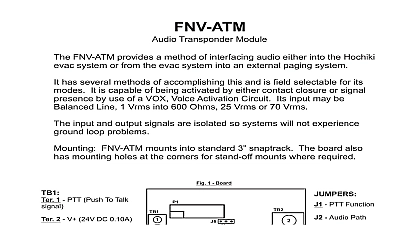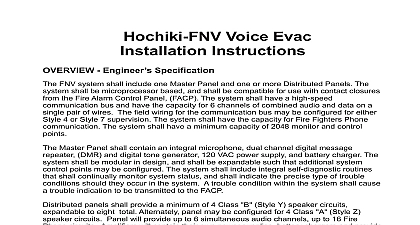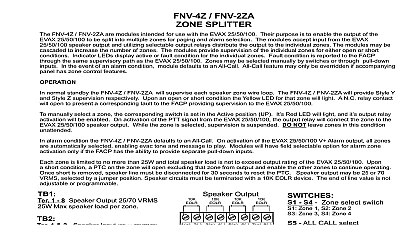Hochiki H-5001 Rev F FNV 25-50-100 Install (11 07)

File Preview
Click below to download for free
Click below to download for free
File Data
| Name | hochiki-h-5001-rev-f-fnv-25-50-100-install-11-07-4713089562.pdf |
|---|---|
| Type | |
| Size | 797.81 KB |
| Downloads |
Text Preview
FNV 25 FNV 50 FNV 100 EVACUATION INTERFACE SYSTEM INSTRUCTIONS FNV 25 FNV 50 FNV 100 is a self contained amplifier tone generator digital message repeater and supervisory It is designed to be used in conjunction with a UL listed Fire Alarm Control Panel FACP to provide a Listed Voice Alarm System FACP provides all initiating circuitry and a signaling circuit to the FNV 25 FNV 50 FNV 100 The FNV 25 FNV 50 100 provides its own internal supervision as well as supervision for its speaker lines Any fault is reported back to the In normal standby the supervisory circuit from the panel is connected to a matching EOLR Should the FNV 25 50 FNV 100 suffer an internal failure or should there be any fault on the speaker line a contact would open and the would report it as an open fault for that circuit FNV 25 FNV 50 FNV 100 is designed to be powered from 120 VAC at 60 Hz The FNV 25 will provide 25W to the speaker circuit The FNV 50 will provide 50W The FNV 100 will provide 100W Speakers may be 25 or 70 VRMS selected 25 V is factory set must insure that all wiring and devices installed in system meet the following standards National Electrical Code NFPA 70 NFPA Standard 72 Life Safety Code NFPA 101 equipment in a clean dry environment avoid installation where equipment could be subjected to vibration electronic assemblies from the enclosure prior to any drilling or punching of the enclosure Where possible all cable entries from the rear or sides Before making any modifications to the enclosure be certain that they not interfere with assemblies or batteries Refer to wiring and terminal designation diagrams Connect speaker lines to TB1 5 6 observe polarity and insure all speakers are connected likewise Class A Style Z the returns are TB1 7 8 Insure that the microphone is attached to connector P2 If Microphone is not installed insure that switch SN2 8 is the OFF position Attach the appropriate EOLR for the FACP to TB3 3 4 and TB3 5 6 The TB3 term 5 6 value must be placed at the of the speaker line as well You must use EOLR value as specified in the FACP manufactures installation instructions for the indicating appliance circuit Note if your system includes one or more EVX 4Z zone splitters the FACP is relocated See EVX 4Z install instructions P N 1 5010 Rev C Connect FACP signaling circuit to TB1 3 4 Alarm Polarity alarm polarity is shown Connect 120 VAC 60 Hz power to the black and white pigtail leads from transformer primary ground lead to grounding stud in cabinet Once power is on to the unit connect battery wiring harness Red Black Observe polarity Minimum battery is 24V 7AHr Maximum battery size is 18Ahr on FNV 25 50 24Ahr on FNV 100 use 2 12V batteries connected in see typical installation diagram If the unit does not have its own batteries and relies on an external power supply with battery back up insure that switch SN2 7 is in the OFF position NOTE Wiring for batteries is Non Power Limited must be taken to insure that all Power Limited wiring maintain a minimum spacing of from any Non Power Limited If batteries must be located in separate enclosure provide separate conduit run for battery wiring only all power and circuits are connected the Green LED will remain on to indicate that the FNV 25 FNV 50 100 is fully operational and all circuits are nominal H 5001 REV F 1 of 8 Village Drive Suite 100 Park CA 90621 2268 Technical Support 25 FNV 50 FNV 100 DESIGNATIONS 1 2 Power Input 24 32V AC DC NOTE 1 4 3 4 FACP Signal Circuit Input 10mA max Alarm Polarity shown NOTE 4 5 6 25 70 VRMS Speaker Loop Style Y Z Class start NOTE 2 wiring connections wire clamp screw 14 18 AWG wire clamp screw 12 18 AWG wire entry terminal 18 26 AWG gauge determined by circuit load 1 2 NOTE 1 4 FACP Supervisory See installation page 5 diagram 2 details 32V 0.4A max Factory set for none J1 3 4 Signal Supervisory EOLR 5 6 EOLR for speaker circuit 7 NOTE 1 3 5 purpose output pulls circuit neg on fault 32V 0.2A max Not for Fire Signaling use 1 2 3 25V NOTES 1 Intended for connection to Class 2 Class 3 Power sources only 2 Power Limited 3 Non Supervised 4 Supervised 5 Terminating equipment must installed in same room as FACTORY DEFAULT SWITCH JUMPER SETTINGS OFF 8 sec initial delay ON OFF ON 8 sec repeat delay OFF ON Message On OFF 3 Repeats ON Network Detail SN2 OFF Temporal Whoop Signal OFF OFF Fault Code Lock default up off X Do not use default up off AC Fault Delay ON Battery connected ON Mic connected J1 A B 2 SHORT J2 VRMS 2 3 SHORT VRMS 1 2 SHORT change output voltage shorting block J5 2 SHORT Ground Fault Enable 1 Circuit Neg 2 NOTE 1 3 Aux Audio Input 0.5V nominal 1VRMS 1mA max 3 NOTE 1 3 5 PreAmp In Out 600 Ohm 0dBm 4 NOTE 1 3 5 Master Programmable 24VDC Active Slave 24VDC Input 5 NOTE 1 3 5 Signal Active Master Out Slave In 6 NOTE 1 3 Aux Audio Enable 24V 32V 5mA max 7 NOTE 1 3 Aux Signal Activate 24V 32V 5mA max 8 NOTE 2 3 5 Alarm Voltage 24V when unit is in alarm condition 0.1A 9 NOTE 2 3 Int V 24V disconnected in alarm condition 0.1A 10 NOTE 2 3 V 24V 0.1A 11 NOTE 5 Mic PTT 24V 0.1A H 5001 REV F 2 of 8 Village Drive Suite 100 Park CA 90621 2268 Technical Support 24VDC OUTPUT TB2 4,8 9 10 terminals provide a max 200 mA of regulated 24VDC power for auxiliary functions Do not exceed 200 mA load combined on terminals For connection to Listed General Signal devices only Non Fire Protective Signaling applications Terminal 4 activation is programmed in the U6 ePROM chip Standard chips are programmed for TB2 4 to go active 24VDC under the following conditions Signal Active Aux Audio Enable Bell Circuit Active RSI Active Reprogramming of these functions must be done at the factory require replacing eprom U6 OF AN AUX AUDIO SOURCE TB2 1 2 aux audio source from additional paging equipment may be connected to the FNV 25 50 100 to augment an existing paging system is not intended for continuous signal input but may be used for paging applications For such an operation the Aux Audio Enable input must be powered from Int V TB2 9 This is to insure that in the event of an alarm the aux audio will not override the evacuation See Wiring Diagram 5 for connection detail SUPERVISORY CIRCUIT TB3 1 2 place of normal supervision via the signaling circuit an alternate method may be employed using any supervisory circuit from the FACP would be made to Terminal Block 3 Ter 1 and 2 This would provide a normally closed connection to the EOLR on Ter 3 4 The relay contact in the circuit will open upon any trouble condition and report an open circuit trouble to the FACP jumper shorting blocks A and B must be removed from J1 if a circuit is to be connected in this manner See Optional Supervisory Application Wiring Diagram 2 for connection detail normal standby the Green LED will remain on alarm condition the Red LED will remain on as long as the unit is in alarm Green LED will also remain on Sequence Factory settings Tone Alarm Signal 5 seconds Digital Message plays Alarm Signal 5 seconds Digital Message plays Alarm Signal seconds Digital Message plays unit reverts to Alarm Signal until alarm condition is cleared If the Mic is keyed it will override the tone and the message so a direct broadcast may be made If this occurs during the initial sequence the digital message will be reset and will not play the Mic is keyed or when the message is played the Green LED will dim The intensity of the Green LED will vary with level of the broadcast audio This is true in Alarm condition as well a fault condition the Yellow LED will remain on The Green LED will flash The number of flashes display a code depending the specific type of fault When there is a fault condition the contact connecting the FACP signal circuit to the EOLR will open indicating the fault to the panel which will provide annunciation Dur


